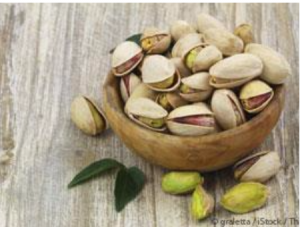Pistachios have been enjoyed in the Middle East, where they originated, for thousands of years. Once considered a delicacy, they became a popular snack in the US during the 1880s, when imported pistachios were available from vending machines in bars, restaurants, and train stations. At that time, you could get “a dozen pistachios for a nickel.”
Pistachios didn’t become widely cultivated in the US until relatively recently; the first commercial crop in the US was harvested in 1976. Today, pistachios are grown in California, Arizona, and New Mexico.
 Many people feel guilty indulging in nuts, believing them to be too high in fat. But pistachios, like most nuts, are high in fats that are beneficial to your health, and contain many other health-boosting properties as well. Nutritionally, over half the fat in pistachios is from oleic acid, the same fat that is in olive oil. One cup would have 56 grams of fat, 26 grams of protein, and only 13 grams of carbs. Contrast this to macadamia nuts where one cup has nearly twice the fat and half the protein and 19 grams of carbs.
Many people feel guilty indulging in nuts, believing them to be too high in fat. But pistachios, like most nuts, are high in fats that are beneficial to your health, and contain many other health-boosting properties as well. Nutritionally, over half the fat in pistachios is from oleic acid, the same fat that is in olive oil. One cup would have 56 grams of fat, 26 grams of protein, and only 13 grams of carbs. Contrast this to macadamia nuts where one cup has nearly twice the fat and half the protein and 19 grams of carbs.
Pistachios Support Heart Health, Especially in People with Diabetes Nuts are well established in the medical literature to help reduce your risk of heart disease, and this is especially important in people with type 2 diabetes, who have higher risks of heart problems. A recent study found eating two servings of pistachios a day lowered vascular constriction during stress, which means the load on your heart is reduced since your arteries are more dilated. Those eating pistachios also had significantly lower blood pressure, specifically systolic blood pressure during sleep. A study in the journal Circulation found people with abnormally high levels of lipids, such as cholesterol, in their blood were able to significantly reduce their risk factors for coronary heart disease by snacking on nuts while those who snacked on whole-wheat muffins got no such benefit. If you are interested in protecting your heart, snacking on nuts is a far better option than snacking on whole grains, which are often touted as a heart-healthy choice.
Pistachios High in Anti-Oxidants
Pistachios are high in lutein, beta-carotene, and gamma-tocopherol (vitamin E) compared to other nuts. Eating one or two servings of pistachios a day has been shown, in fact, to increase blood levels of antioxidants and, in turn, lower oxidized LDL cholesterol in people with elevated levels.
While most people think of fruits and vegetables when it comes to increasing antioxidant intake, the research suggests that eating pistachios is another simple strategy to consume more of these beneficial phytochemicals.
Pistachios Target Belly Fat
If weight loss is on your agenda, snacking on nuts makes sense. Rich in satiety-inducing protein, fat, and fiber, research shows that eating nuts two or more times per week is associated with a reduced risk of weight gain. When people eat nuts, it seems, they often use them to replace processed foods, which is one reason why they’re associated with weight loss. Further, they’re an excellent source of monounsaturated fatty acids, which tend to preferentially target belly fat.
A recent study suggests eating in-shell pistachios can help you to eat 41% fewer calories without even trying to restrict them. A second study found that leaving empty pistachio shells on your desk after consumption reduces calorie intake by another 18% compared to discarding the shells immediately, maybe because the remaining shells, it seems, help to serve as a visual reminder of how much you’ve eaten, helping you become more mindful of your food intake.
A Word of Caution – Avoid Bleached Pistachios
Pistachios are an extremely perishable, fragile crop. Once harvested, they must be processed within 24 hours or else tannins released from the nut’s hull can lead to staining on the shell. Stained pistachios can no longer be sold in shell, and must be removed and sold as nutmeats.
You may have seen red or green dyed pistachios on the market, and this is often done to hide such staining. Naturally, pistachio shells are light beige in color. White shells demonstrate that they have been bleached. Beware: Aside from the potential for bleach residues to remain on the nuts, bleaching has been shown to destroy important phytochemicals in pistachio skins, with researchers noting that the destruction of bioactive phenolics in pistachio skins
California pistachio shells are not bleached, however, once hulled they may be soaked in a “bath” of water and antimicrobial chemicals. The nuts are then moved to conveyer belts to be dried, but are first washed with a water spray to remove any additional organic matter. To avoid nuts that have been treated with antimicrobials and pesticides, choose organic pistachios.
